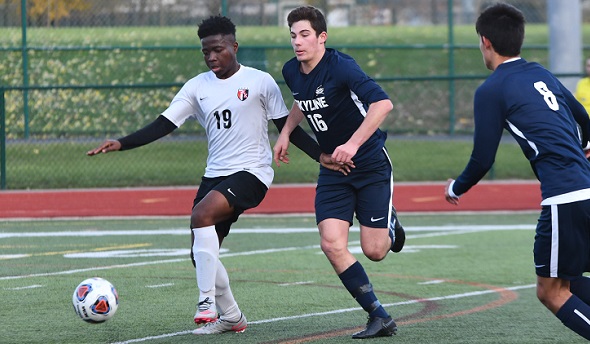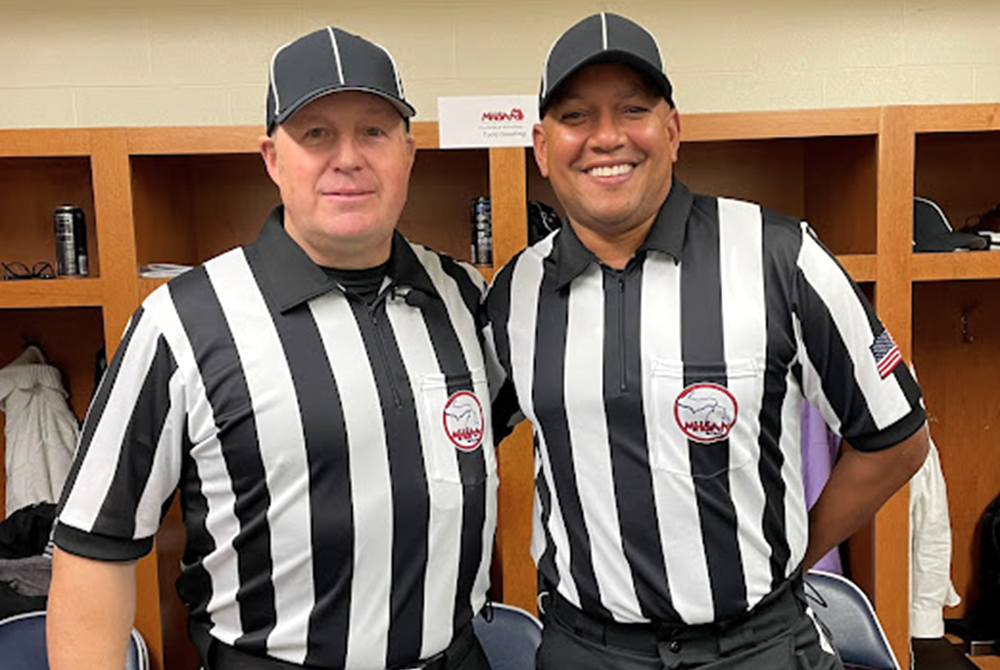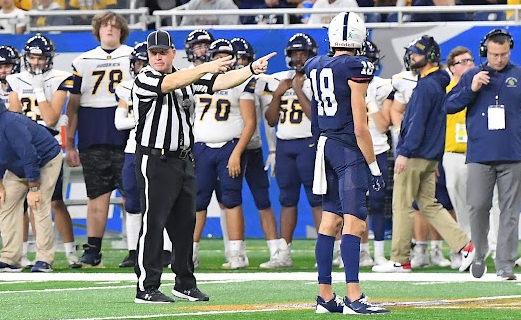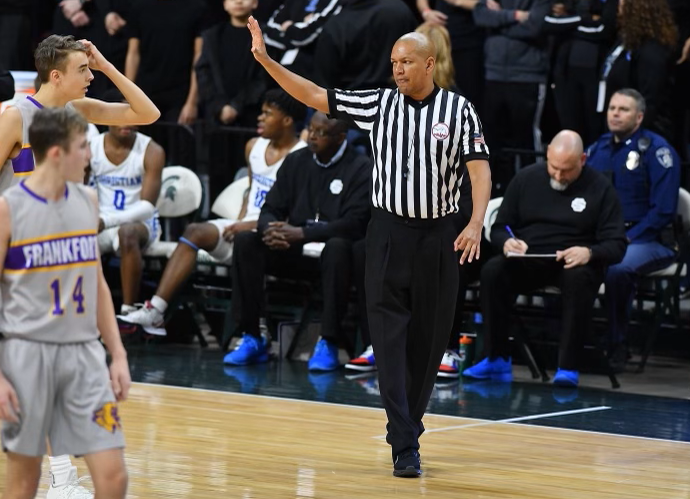
Soccer, Hoops Next to Seed Using MPR
August 6, 2019
By Rob Kaminski
MHSAA benchmarks editor
As the topic of seeding for MHSAA Tournaments continues to swirl in the air of numerous committee meetings on an annual basis, one of the primary concerns continues to focus on the simple question: “How?”
The MHSAA for years has been working behind the scenes on potential formulas which could best be used as a standardized tool to assist in measuring strengths of teams in a given sport.
This spring, the MHSAA introduced the Michigan Power Rating in the sport of Boys Lacrosse. The Representative Council approved limited seeding beginning in 2019-20 for girls and boys soccer and girls and boys basketball, and MPR will be the metric to determine which two teams must be seeded on opposite sides of District brackets in those sports.
“The boys lacrosse tournament has been seeded since it was added as an MHSAA-sponsored sport in 2005. The seeding is done by committee based on several criteria, one of which was statewide power rankings generated by a third-party website. In the Fall of 2018, that website ceased operation – it was the perfect opportunity for the MHSAA to develop its own data-driven, purely objective ratings system and incorporate that data into the seeding criteria,” said Cole Malatinsky, administrative assistant for the sport.
“The benefits of the new MPR system have been already mentioned – it is MHSAA controlled, simple, objective, and transparent, and it can be used by other MHSAA sports in the future.”
MPR is a computer rating formula similar to the popular RPI rating. MPR provides a way to measure a team’s strength relative to other teams, based on games played against other MHSAA tournament teams, largely on the strength of their opponents’ schedules. MPR is purely objective using only the game results listed on MHSAA.com – there is no subjective human element.
What is the basic MPR formula?
MPR is calculated using wins, losses and ties for games played between teams entered into the MHSAA tournament. The final MPR number is 25% of the team's winning percentage, plus 50% of its opponent's winning percentage, plus 25% of its opponent's opponent's winning percentage.
MPR = (.25 x W%) + (.50 x OW%) + (.25 x OOW%)
The MPR formula can be applied easily to other MHSAA team sports.
What game data is included in the formula? What game data is not?
MPR looks only at results between opponents entered into the MHSAA postseason tournament. Wins, losses and ties in multi-team shortened game tournaments (lacrosse, soccer) also count. Forfeits also are counted as wins and losses.
MPR does not use the specific scores of a game or the margin of victory in a game. The location of a game is not included in the MPR formula, and the formula weighs results at the beginning of the season the same as results at the end of the season. Scrimmages are not included.
Why use the MPR formula?
Different rating systems have been used in the past or have been recommended to the MHSAA. We wanted to have a rating system where the data was controlled and stored in house and could be used for any sport featuring head-to-head competitions.
With its own rating system the MHSAA also can control the different components of the formula, thus keeping the tenets of scholastic competition at the forefront (like not including margin of victory in the formula). Finally, by listing all scores and team schedules online, as well as showing the MPR calculator on each team schedule page, the ratings are transparent and can be replicated easily.
CALCULATING MPR
What are the detailed components of the MPR formula?
You need three numbers to calculate your MPR: winning percentage (W%), opponent’s winning percentage (OW%) and opponent’s opponent’s winning percentage (OOW%).
How do you calculate winning percentage (W%)?
Divide the number of wins by the number of total games played. A tie is worth half a win. For MPR purposes, find the winning percentage against all teams that will play in the MHSAA tournament (MPR W%). Games played against out-of-state teams, varsity “B” teams, junior varsity teams, non-school club teams, and any other non-MHSAA tournament participants should not be included when calculating winning percentage. W% should be an easy number to calculate.
How do you calculate opponent’s winning percentage (OW%)?
Average the winning percentages of a team's opponents. When calculating the winning percentage of a specific opponent, use the opponents "Adjusted Winning Percentage" (ADJ W%). Adjusted winning percentage eliminates all games the team played against that opponent (as well as its games against non-MHSAA opponents).
For instance, if the team beat an opponent with an overall record of 4-1, use a record of 4-0 (1.000) for that opponent. If the team lost to an opponent, use a record of 3-1 (.750). Find the ADJ W% for all opponents, and then take the average. If a team plays an opponent team twice, that opponent’s ADJ W% will be counted twice.
OW% is not calculated via the combined record of the opponents; instead take the average of all opponent’s winning percentages.
How do you calculate opponent’s opponent’s winning percentage (OOW%)?
Use the same process described above, except calculated for the opponents of a team's opponents. This number is much harder to manually calculate, so the OW% for every team is listed on the MPR page of the MHSAA website.
Again, simply take the average of all opponent’s OW%.
How often is MPR calculated?
MPR is calculated about every five minutes. Enter a score and a minutes later the team MPR and the MPR of all the team's opponents will update.
How much will my MPR change throughout the season?
You will see wild MPR swings in the beginning of the season, but after about 10 games played your MPR will start to level out. At 20 games played you will see very little movement with each additional game played.
My score is missing. How can it be added?
This is a crowd-sourced system. Any registered user of MHSAA.com can add a missing score. ADs, coaches, parents, students and fans all can login and enter a score for any game.
What are some common errors when calculating MPR?
When calculating your team’s winning percentage, only include games against MHSAA-tournament teams. When calculating your opponent’s winning percentage, don’t include the games they played against you. When calculating ties, count the game as a half-win and half-loss.
What happens if a game is cancelled?
Because the MPR system works off of averages, it will not make a difference in the final MPR if a game cannot be rescheduled. It would not penalize, nor benefit, any team involved in that scenario.
USING THE WEBSITE
Where can I find game scores?
A list of statewide scores for all sports can be found in the MHSAA Score Center. To find a schedule for any team click on “Schools & Schedules” in the top navigation bar, search for the school, then once on the school page click the sport. You can also see a list of all schools (with links to schedules), on the statewide MPR list.
“We continue to have great success in score reporting for varsity boys lacrosse contests. While we state that schedule submission and score reporting to MHSAA.com are required, athletic directors and coaches understand that in order for MPR data to be accurate, we need consistent and accurate score reporting,” said Malatinsky. “MHSAA.com is now the primary site for high school boys lacrosse schedules, results and ratings in the state.”
How should I use the statewide list of teams and MPR?
Linked to the boys soccer page (and eventually to be added for both basketball pages and girls soccer) is a statewide listing of all Michigan Power Ratings (MPR) for teams entered into the MHSAA postseason tournament for that sport. Linked on the MPR page is an explanation of the District draw formula, describing when and how teams will be placed on the bracket.
The MPR data updates every five minutes. Click on the column headings to sort the data. You also can use the drop-down menu to show teams in one Division, or type a District number in the box to filter teams for that District (Region for boys lacrosse).
You also can click on any school name to go to its schedule page.
How do I read the school schedule page?
The schedule at the top of the page shows the date and opponent for all scheduled games, and results for games already played. If results are missing, click “Submit Score” to add a game score.
Below the game schedule is the MPR Calculator. The calculator is split into three sections. The first section shows the three MPR component scores for the team, as well as the team’s current MPR score. The second section shows the MPR information for the team’s opponents – specifically, for the opponents the team already has played (actually, for games where scores have been submitted). Only these games are included in the MPR calculation.
The third section highlights future opponents. The MPR data for future opponents are not used in the MPR calculation for the team.
PHOTO: East Kentwood and Ann Arbor Skyline play for last season’s Division 1 boys soccer championship.

Gooding & King Work to Fill SW Michigan's Officiating Ranks, Schedules
By
Pam Shebest
Special for MHSAA.com
December 12, 2023
KALAMAZOO – Cheer them or boo them, without officials, there are no games. That’s just a fact in the sports world.
 Two area men are tasked with supplying those officials for Southwest Michigan schools, and it is not always as easy as it seems.
Two area men are tasked with supplying those officials for Southwest Michigan schools, and it is not always as easy as it seems.
Portage’s Todd Gooding is in charge of assigning football referees for 70 schools across eight leagues, with 500 officials on his staff.
Vicksburg’s Rob King assigns officials for girls and boys basketball in five leagues and has 290 men and women on his roster to work 1,100 games throughout the hoops season.
“We have six females on staff,” King said. “We’re looking to add more. I think the girls who are playing enjoy having a female ref on the court with them, plus it shows them they can do this, too.”
Although totals were dropping a few percentage points every year, the MHSAA still registered an average of 10,317 officials annually during the decade ending in 2019-20. But the beginning of the COVID-19 pandemic that spring played a large part in a decrease in registered officials by 12 percent for 2020-21, down to 8,090.
The last two school years saw a bounce-back of four percent, and recruiting and retaining efforts continue. But Gooding and King – also veteran officials themselves, Gooding for 25 years and King for 24 – and their assigning colleagues across the state have the closest look at the effects of fewer officials as they work to schedule at the local level and make sure everything is covered.
Doing so gets even harder with unforeseen roadblocks.
One of those challenges for Gooding came in August when extreme heat forced most schools to reschedule or delay their football games.
“Everyone was trying to get their games in,” he said. “We were moving start times back, then we were moving days. Football is a little different than basketball or baseball because you can only play within so many days, so we were really squeezed against the schedule.
 “I had a school or two reach out on Monday or Tuesday (before the Friday night game), so they looked ahead at the heat. Some of them waited, waited, waited, and then in some cases, it posed some big challenges because most of those crews had been spoken for.”
“I had a school or two reach out on Monday or Tuesday (before the Friday night game), so they looked ahead at the heat. Some of them waited, waited, waited, and then in some cases, it posed some big challenges because most of those crews had been spoken for.”
For a typical football Friday, Gooding staffs 30 or 35 games, “which is really difficult because everybody wants to play Friday night.”
Some referees in both football and basketball “double dip” by officiating games at freshman or junior varsity levels on nights other than Friday.
Gooding said at one time he hoped to go to seven officials for a football game, but with a shortage of officials, “Right now we’re just lucky to staff five in the games we have, and we’re still very short.
“Parents are a key component to a shortage of officials. A lot of it is more at the youth level, but everyone has to remember the sportsmanship aspect. Without officials there are no games, and sometimes we lose track of that, and that’s one reason there’s a shortage.”
Still, King noted that officiating provides more advantages than disadvantages.
“Everyone hears about the bad stuff, getting yelled at by fans and coaches, but those are so small,” he said.
“After a season of doing this, you learn to block out that stuff and realize it’s just part of the game. Fifty percent of people are mad at you every time you blow the whistle, so you get used to that.”
Pay raises in some leagues enticed many of those who “retired” to return, King said, but both he and Gooding agree the camaraderie developed while officiating is what makes it most special.
“It’s more about the time you spend on the floor with guys, in the locker room, driving to games, grabbing something to eat after the games, just talking about life, just building friendships,” King said. “That’s the part you remember.”
Gooding added some games stick in his memory more than others.
“My first varsity game (refereeing) was Lawton playing Saugatuck,” he said. “I show up and Channel 3 was there. I wondered what’s going on.
“Both schools were 0-8, both senior classes were 0-35. Somebody had to win, and it was my first varsity game. I think Saugatuck won, and it was close to 25 years ago.”
Another memory came as he officiated a basketball game.
 “A girl from Benton Harbor (Kysre Gondrezick in 2016) had 72 points,” he said. “It’s in the record books. and you’re just one small part of that and you remember them.”
“A girl from Benton Harbor (Kysre Gondrezick in 2016) had 72 points,” he said. “It’s in the record books. and you’re just one small part of that and you remember them.”
Officiating is not only for adults. Even teenagers still in high school can become referees as part of the MHSAA Legacy Program.
King recently hosted an officiating summit at Paw Paw for high school athletes.
“There are nine schools in the Wolverine Conference and six of them brought 10 to 15 kids,” he said. “Myself and another official presented on basketball. They also did something on other sports.
“We got the kids up blowing the whistles and doing some of the signals. Three reached out wanting to get involved.”
King said officiating is a great way to earn money, especially while in college.
“You’ll work maybe two or three hours at the most and make $150 to $300 depending on the level,” he said. “Your friends will have to work six-, seven-, eight-hour days to make that much money.
“You can also block your schedule. We have a software with a calendar on it. If there are days you know you can’t work because you have classes or other things, you just block those days out, so you control your own schedule.”
With training, freshmen and sophomores can work junior high/middle school games, and juniors and seniors are able to officiate at the freshman and junior varsity levels.
“Usually what we do is get you a mentor,” King said, “and you work with that mentor and make some money.”
Those Legacy officials hopefully continue in the avocation, eventually becoming the next mentors.
Officiating, like school sports in general, is a cycle that’s constantly in motion – both when it comes to filling the ranks and filling the schedule to cover games ahead.
For example, although football season is over, “I don’t know if there really is an offseason,” Gooding said. “Leagues are going to start giving me their schedules. We’ll get those into an Arbiter system. Everything’s assigned by Arbiter, a computer system where officials get their assignments.
“I’ll start evaluating the crews, reach out to the crew chiefs. They’ll let me know any changes in their crew dynamics. I’ll evaluate the year gone by, how they performed and then start getting ready to work on getting those games staffed. That will start after the new year.”
For more information on officiating, including the Legacy Program, go to the Officials page of MHSAA.com.
 Pam Shebest served as a sportswriter at the Kalamazoo Gazette from 1985-2009 after 11 years part-time with the Gazette while teaching French and English at White Pigeon High School. She can be reached at [email protected] with story ideas for Calhoun, Kalamazoo and Van Buren counties.
Pam Shebest served as a sportswriter at the Kalamazoo Gazette from 1985-2009 after 11 years part-time with the Gazette while teaching French and English at White Pigeon High School. She can be reached at [email protected] with story ideas for Calhoun, Kalamazoo and Van Buren counties.
PHOTOS (Top) Todd Gooding, left and Rob King take a photo together while officiating the Division 4 Final at Ford Field in 2022. (Middle) Gooding signals during that contest between Goodrich and Grand Rapids South Christian. (Below) King officiates the 2019 Division 4 Boys Basketball Final at Breslin Center. (Photos courtesy of Gooding and King.)

